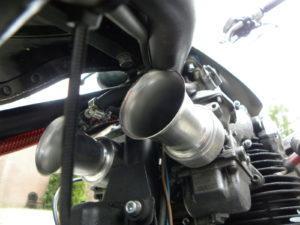Oldskool tuning. Nowadays, with some chip tuning, you have just 30 horsepower. Hoppa!
It used to be different. During the tuning, the 'tuning', with files and milling the breathing was worked on and the adjustment of a set of double Webers did not happen from a keyboard. We called that breathing improvement the flow of the block. How does that work? Remove from the inlet channel (and somewhat less importantly, the outlet channel) all irregularities that result in a sudden narrowing or dilation. For the same reason you can shorten the guides of the inlet valves. That makes a big difference (the filling level gets better, but the valve guides wear out faster, the Honda CB750 OHC FII was an example of that).
The polishing of inlet and outlet channels is counterproductive. So don't.
The dynamic balancing of the engine also gives a profit. With serial engines (much) power is lost due to internal imbalance. A block of which crankshaft / flywheel / pistons / connecting rods are balanced turns nicer and more vibration-free, turns easier and more rpm and therefore delivers more power.
Increasing the compression by flattening the head or the engine block gives power gain plus the risk that the engine will ping. Adjusting the ignition time is important. Do not flatten the head or the block so much that the engine turns into a diesel :-).
The inhalation is important
Tuning is optimizing. Therefore, ensure optimal air intake. Provide the largest possible filter (NEVER an imitation K&N filter) and a gradual transition from the diameter of the filter to the carburettor. Any sound insulation through chambers and partitions in the air filter housing and suction pipes can be removed.
Provide cool air. More oxygen 'fits' into cool air. Cool air can also prevent pinging. So suck in the air from a cool place, not above the outlet for example. It is not for nothing that tuned engines often have an air intake above the carburetors.
Make sure you have the right mixture. A few dynojet runs including re-adjusting the carburation are a great investment. We have experienced that a Simca Rally 3 on the couch just got 16 pk on the rear wheels stronger.
A step further
Then it becomes pretty radical tuning:
* Fit larger valves.
* Fit another (larger or more) carburetor (s). Remember that the purchase of those carburetor (s) is only a part of the expenditure, adjusting those carburetors on the test bench costs extra because not every carburetor functions equally well in every setup. Fortunately there are a few specialists who fully control this game.
* Mount a camshaft with higher ('hot') cams.
Or cheaper: Fit an adapter plate with which you can adjust the camshaft a few degrees later than the factory value. A camshaft can easily be set approximately 5 degrees later, whereby the speed of the maximum torque shifts upwards.
Choose the correct length of intake manifolds: shorter 'thick' manifolds give more power at a higher speed. Long intake routes give a smoother run. Of course everything can be calculated and made yourself, but there is usually a wide choice of intake and exhaust manifolds for engines that are tuned more often or have been available in various versions.
Install heavier valve springs and try to make the valve mechanism lighter. And then watch out for floating valves.
Adjust the ignition: you can often ignite a few degrees earlier and earlier igniting gives more power at the top. A completely electronic ignition unit where the ignition curve can be adjusted is certainly an option.
The exhalation
A standard exhaust system is made to be cheap and quiet. An exhaust manifold where the bends have coordinated (identical) lengths and end up with a breathing damper system that is as free as possible gives a profit. Provided the nozzle occupation of the carburetors is adjusted to it (Dynojet)
Every kilo equals one horsepower
That is an old wisdom from the 50 cc racing world. Every kilo that a car becomes lighter ... There are people who therefore leave their tools, their spare wheel and their partner at home.





